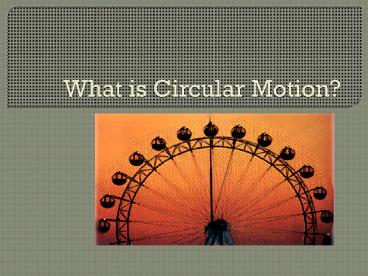What is Circular Motion? - PowerPoint PPT Presentation
1 / 20
Title:
What is Circular Motion?
Description:
Motion of an object travelling at constant speed in a circle Let s explore the kinematics of circular motion. Why is it accelerating, if the speed is constant? – PowerPoint PPT presentation
Number of Views:185
Avg rating:3.0/5.0
Title: What is Circular Motion?
1
What is Circular Motion?
2
Uniform Circular Motion
- Motion of an object travelling at constant speed
in a circle - Lets explore the kinematics of circular motion.
- Why is it accelerating, if the speed is constant?
- What would cause an object to move in a circle?
3
What is Centripetal Force?
- Objects move in a straight line at a constant
speed unless a force acts on them. This is
Newton's First Law. - However, many things move in curved paths,
especially circles, and so there must be a force
acting - on them to pull them out
- of their straight line paths
- and make them turn
- corners.
4
What Does Centripetal Force Depend On?
- We call the force that makes objects move in a
circle the CENTRIPETAL FORCE(the name comes from
Latin and means centre-seeking) - How is Centripetal Force related to
- Mass of object?
- Velocity of object?
- Radius size of circle?
- Lets Explore!
5
Uniform circular motion
The speed stays constant, but the direction
changes
v
R
The acceleration in this case is
called centripetal acceleration
6
Wide turns and tight turns
little R
big R
for the same speed, the tighter turn requires
more acceleration
7
Lets Determine the Velocity of an Object
Travelling in a Circle
- Remember Speed Distance/Time
- Lets define Period (T) as the time it takes the
object to travel once around the circle. - How far does it travel in one rotation?
- Therefore
8
Ball on a string
The tension in the string provides the
necessary centripetal force to keep the ball
going in a circle.
path of ball if the string breaks
9
Example
- What is the tension in a string used to twirl a
0.3 kg ball at a speed of 2 m/s in a circle of 1
meter radius? - Force mass x acceleration m ? aC
- acceleration aC v2 / R (2 m/s)2/ 1 m
- 4 m/s2
- force m aC 0.3 ? 4 1.2 N
- If the string is not strong enough to handle this
tension it will break and the ball goes off in a
straight line.
10
Motion On A Flat Curve
- On a flat, level curve, the friction between the
tires and the road supplies the centripetal
force. - If the tires are worn smooth or the road is icy
or oily, this friction force will not be
available. - The car will not be able to move in a circle, it
will keep going in a straight line and therefore
go off the road.
11
Whats this Centrifugal force ? ?
- The red object will make the turn only if there
is enough friction on it - Otherwise it goes straight
- The apparent outward force is called the
centrifugal force - It is NOT A REAL force!
- An object will not move in a circle until
something makes it, in this case the car door!
object on the dashboard
straight line object naturally follows
12
What is Gravitational Force?
- Sir Isaac Newton discovered that every particle
attracts every other particle in the universe
with a force when he saw an apple fall from a
tree towards the earth. - The force of attraction between any two particles
in the universe is called Gravitation or
gravitational force
13
Newtons Law of Universal Gravitation
G is the universal gravitational constant and
equals 6.673 x 10-11 N?m2 / kg2
14
G vs. g
- Always distinguish between G and g
- G is the universal gravitational constant
- It is the same everywhere
- g is the acceleration due to gravity
- g 9.80 m/s2 at the surface of the Earth
- g will vary by location
15
Why doesnt the moon fall into the earth?
- The moon is actually falling toward Earth but has
great enough tangential velocity to avoid hitting
Earth. - If the moon did not fall, it would follow a
straight-line path.
16
Newtons Hypothesis
17
Johannes Kepler
- 1571 1630
- German astronomer
- Best known for developing laws of planetary
motion - Based on the observations of Tycho Brahe
18
Keplers Laws
- Keplers First Law
- All planets move in elliptical orbits with the
Sun at one focus - Keplers Second Law
- The radius vector drawn from the Sun to a planet
sweeps out equal areas in equal time intervals - Keplers Third Law
- The square of the orbital period of any planet is
proportional to the cube of the semimajor axis of
the elliptical orbit
19
Keplers Third Law
- Can be predicted from the inverse square law
- Start by assuming a circular orbit
- The gravitational force supplies a centripetal
force - Ks is a constant
20
Mass of the Sun
- Using the distance between the Earth and the Sun,
and the period of the Earths orbit, Keplers
Third Law can be used to find the mass of the Sun - Similarly, the mass of any object being orbited
can be found if you know information about
objects orbiting it































